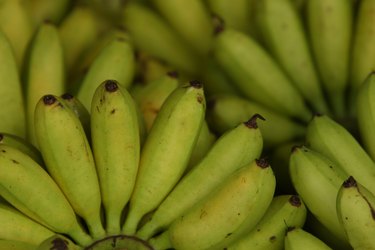
Bananas have thick inedible skins that turn yellow or red when ripe. As the most popular fruit in the world, they grow on trees in the subtropics and tropics. You can eat some varieties after skinning them, but some are inedible raw.
Common Types
Video of the Day
Of the 1000 known banana varieties in the world, the types most commonly available for purchase include the most popular yellow Cavendish, the smaller apple banana, the baby banana, the red banana with pinkish flesh and the plantain, which must be cooked.
Video of the Day
Nutrients
Rich in potassium and vitamins B6 and C, bananas also contain essential amino acids, high amounts of carbohydrate and fiber, but low amounts of protein and fat.
Important Commodity
Although people in the tropics consume bananas as a staple food, developing countries export about one fifth of their banana crop to developed countries, according to the United Nations Conference on Trade and Development. Both large plantations and small farmers grow bananas for export.
Shipping
Exporters ship unripe bananas to extend their shelf life. Once the fruit arrives, vendors treat it with ethylene gas to speed the ripening process.
Storing Bananas
Keep the fruit at room temperature or put them in the sun for faster ripening. Don't refrigerate them because that will turn them black and they won't ripen.